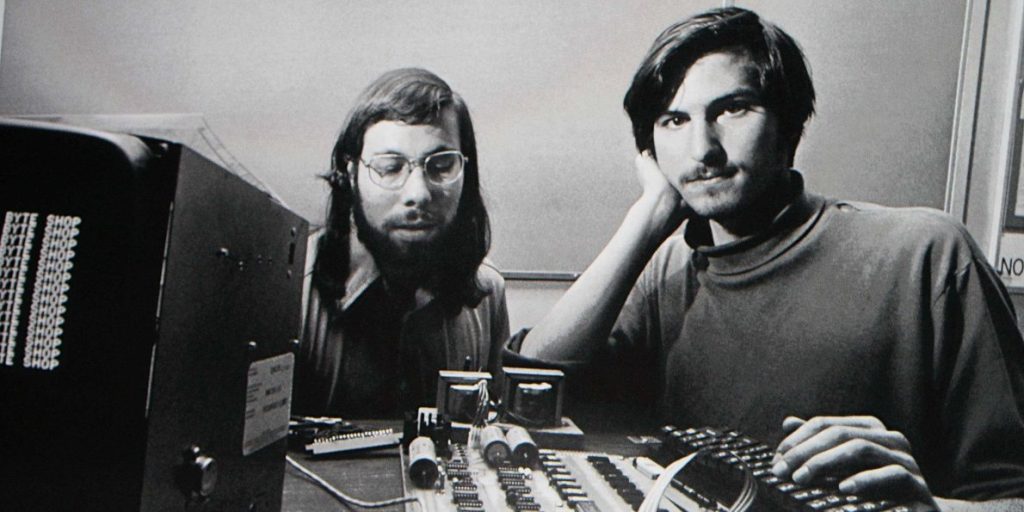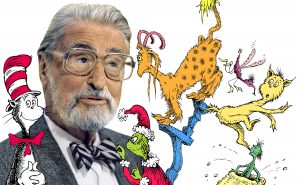Winner of the Fall 2017 StMU History Media Award for
Best Article in the Category of “People”
It was a sunny summer day. A sea of graduates, proud parents, family members, and faculty had their sights fixed on a bony and haggard individual. It seemed age had already taken possession of his body, making him look somewhat fragile and weak. Yet, he radiated forcefulness. The man was none other than Steve Jobs, ready to deliver Stanford’s Class of 2005 Commencement Speech. By that year, Jobs had gone through many hardships—he had been fired from the company he started, and he had undergone intricate medical procedures due to pancreatic cancer, just to name a few. Amidst the tragedies in his life, he transmitted nothing but the serenity of a man that had accomplished what he desired in life. One of his initial remarks was “Your work is going to fill a large part of your life, and the only way to be truly satisfied is to do what you believe is great work. And the only way to do great work is to love what you do. If you haven’t found it yet, keep looking. Don’t settle. As with all matters of the heart, you’ll know when you find it.”1 However, how exactly did Jobs find his dream job? Specifically, what was the genesis of Apple Inc?

“I did go to college… [and] after six months, I couldn’t see the value in it. I had no idea what I wanted to do with my life and no idea how college was going to help me figure it out.”4 In his academic hiatus, Steve encountered many things. He experienced psychedelic drugs, and sought to find spiritual enlightenment in India. He rekindled a friendship that would later serve as catalyst for the creation of the most powerful electronic company of all time, Apple Inc. His friend was Steve Wozniak, a talented, self-taught electronics engineer, whom Jobs had met in his high school years through common friends.5 Like himself, Steve Wozniak was an electronics enthusiast. After having part-time jobs with Atari and Hewlett-Packard, Jobs had found his passion—anything electronics.6 “I was lucky—I found what I loved to do early in life.”7 The two Steves, in love with computers, began their first commercial venture in 1975, when Jobs was only twenty years old.8
Their first creations were called “blue boxes”—electronic boxes that allowed anyone to make cost-free long-distance phone calls.9 Jobs invested $40 in parts and sold the boxes door-to-door in college dorm rooms for $150 apiece, splitting the profits with Wozniak.10 Although their first creation had to be shut down because of its illicit intentions, it proved that the two Steves were perfect business partners. Many attribute Apple’s early success to the natural connection the two Steve’s shared. Wozniak has commented,”we had so much in common. Normally, it was hard for me to explain to people the kind of designs I worked with, but Steve got it right away.”11 Similarly, Jobs explained, “He was the only person I met who knew more about electronics than me.”12 Despite their different personalities, they complemented each other in a wonderful manner. Steve Wozniak contributed with his technological savvy, and Steve Jobs with his entrepreneurial charisma. Aware of this powerful interrelation, they decided to take their collaborative efforts to the next level.

Jobs and Wozniak regularly attended Homebrew Computer Club (HCC), where they swapped ideas with other hobbyists who dreamed of building their own computers.13 It was there that they recognized the market for smaller, cheaper, intuitive, and accessible computer machines for everyday consumers. In his very first HCC meeting, Wozniak recalls, “the complete vision of a personal computer suddenly appeared in my head. That night I began to make sketches on paper of what later became known as the Apple I.14 Just as he had with the blue boxes, Jobs quickly recognize the potential to profit from a computer that Wozniak had designed to show off at the HCC.15
Their new venture—the Apple I. Jobs convinced Wozniak that they should sell the computers as a product. “Steve [Jobs] didn’t do one circuit of design for the first computer…but it was his idea to sell them,” Wozniak recalls.16 In order to finance their bold creation, Jobs parted with his red and white Volkswagen bus for $1,500 and Wozniak with his beloved HP-65 programmable calculator for $250.
Every day after that, Wozniak would work on the first prototype in his Hewlett-Packard cubicle, spreading the pieces out and deciding where they should be placed and welded.17 By 1975, “Woz” had successfully created the first personal computer with a typewriter-like keyboard able to connect to a regular TV as a screen. Just like that, the archetype of the modern personal computer and the start-up of the biggest company in the world was up and running. The two Steves were ready to take their simple computer to the market, but first, they needed a name for their company. As the two drove along Highway 85 between Palo Alto and Los Altos, Jobs blurted out “I’ve got a name: Apple Computer.”18 It was Jobs who came up with “Apple.” He thought the name sounded “fun, spirited and not intimidating.” Although they tried to think of more technical sounding names, nothing was able to beat “Apple Computer.”

Realizing that Apple would be hopelessly deadlocked if they disagreed on any major issues, the two sought someone who could serve as a tiebreaker and help get the company off the ground. That man was Ronald G. Wayne, a video game maker’s chief draftsman. Jobs enticed Wayne to become a partner in Apple by offering ten percent interest in the company, with the remainder split between Jobs and Wozniak. The three formally filed the partnership papers for Apple Computer Company on April Fool’s Day, 1976.19 By 1976, Apple Inc was open for business, and Jobs was only twenty-one years old. Wozniak conceived of a series of user-friendly personal computers, and—with Jobs in charge of marketing—Apple set the list price of the original 4K Apple I at $666.66 each.20 Immediately, Jobs began hustling up customers. Paul Jay Terrel—owner of the first retail computer store chain in the country “Byte Shop”—agreed to buy fifty computers for $500 each, cash on delivery.
The order was placed, the only problem—they had no working station. In a daring move, 11161 Crist Drive in Los Altos (Steve’s home), became the assembly center of the Apple I. The 24-by-24 ft cramped space in Jobs’s garage was transformed into an impromptu workshop. The two Steve’s had thirty full days to complete the Byte Shop’s request. Having no employees, and very little time, the two Steves recruited all available hands, from college students to Jobs’ pregnant sister Patty. Around ten workers were roped in to sit at a kitchen table to solder parts and set up boards. Exceedingly long working hours. Enormous amounts of caffeine. Countless failed models. No sleep. The small garage became so labor intensive that Paul Jobs (Steve’s father), had to stop repairing old cars so that the Apple kids could have all of the garage for themselves. Defying all odds, however, the company’s first batch of Apple I’s was completed within the month. With fifty Apple I’s completed, their first formal contract generated the rookie company a total of $25,000.21

Although there were a few bumps along the road, and a couple of not so successful products, it seemed that every year this company got better and better. They would go on to release trendsetting and ground-breaking products such as the Macintosh with its revolutionary mouse, the MacBook laptop computer, and the ubiquitous iPods, iPhones, and iPads that we cannot live without today. Ultimately, Apple became the most powerful electronic industry of all time. Its dominance is undisputed, generating a colossal $108.25 billion in sales today.
It is truly amazing to see how this company originated in a college drop out’s garage. Jobs’ early career success, dramatic ouster from the company he built, and ultimate transformation of Apple into one of America’s largest multi-billion dollar companies encapsulates the American dream.22 His untimely death left questions unanswered about the products he might have invented or what he might have accomplished later in life. Nevertheless, he made it clear to all that we should strive to reach our dreams, and work hard for them. As he said at the end of his Stanford speech, “Stay Hungry. Stay Foolish.”23
- Steve Jobs, “How to Live before you Die,” (Commencement Address, Stanford University, Stanford, June 12, 2005). ↵
- Walter Isaacson, Steve Jobs (New York: Simon & Schuster, 2011): 52. ↵
- Anna Wong, “A Lesson for Public Schools From Steve Jobs,” The Huffington Post, last modified October 9, 2012 https://www.huffingtonpost.com/anna-wong/steve-jobs-education_b_1762277.html. ↵
- Steve Jobs, “How to Live before you Die” (Commencement Address, Stanford University, Stanford, June 12, 2005). ↵
- International Directory of Company Histories, 2012, s.v. “Apple,” by Scott Lewis, Jeffrey L. Covell and Mark Lane. ↵
- Owen W. Linzmayer, Apple Confidential 2.0: The Definitive History of the World’s Most Colorful Company (San Francisco: No Starch Press, 2004): 2. ↵
- Steve Jobs, “How to Live before you Die,” (Commencement Address, Stanford University, Stanford, June 12, 2005). ↵
- Owen W. Linzmayer, Apple Confidential 2.0: The Definitive History of the World’s Most Colorful Company (San Francisco: No Starch Press, 2004): 2. ↵
- International Directory of Company Histories, 2012, s.v. “Apple,” by Scott Lewis, Jeffrey L. Covell, and Mark Lane. ↵
- Owen W. Linzmayer, Apple Confidential 2.0: The Definitive History of the World’s Most Colorful Company (San Francisco: No Starch Press, 2004): 3. ↵
- Walter Isaacson, Steve Jobs (New York: Simon & Schuster, 2011): 85. ↵
- Owen W. Linzmayer, Apple Confidential 2.0: The Definitive History of the World’s Most Colorful Company (San Francisco: No Starch Press, 2004): 3. ↵
- Owen W. Linzmayer, Apple Confidential 2.0: The Definitive History of the World’s Most Colorful Company (San Francisco: No Starch Press, 2004): 5. ↵
- Walter Isaacson, Steve Jobs (New York: Simon & Schuster, 2011): 170. ↵
- Owen W. Linzmayer, Apple Confidential 2.0: The Definitive History of the World’s Most Colorful Company (San Francisco: No Starch Press, 2004): 5. ↵
- Owen W. Linzmayer, Apple Confidential 2.0: The Definitive History of the World’s Most Colorful Company (San Francisco: No Starch Press, 2004): 6. ↵
- Walter Isaacson, Steve Jobs (New York: Simon & Schuster, 2011): 171. ↵
- Owen W. Linzmayer, Apple Confidential 2.0: The Definitive History of the World’s Most Colorful Company (San Francisco: No Starch Press, 2004): 6. ↵
- Owen W. Linzmayer, Apple Confidential 2.0: The Definitive History of the World’s Most Colorful Company (San Francisco: No Starch Press, 2004): 6. ↵
- Owen W. Linzmayer, Apple Confidential 2.0: The Definitive History of the World’s Most Colorful Company (San Francisco: No Starch Press, 2004): 7. ↵
- Owen W. Linzmayer, Apple Confidential 2.0: The Definitive History of the World’s Most Colorful Company (San Francisco: No Starch Press, 2004): 7. ↵
- Amy E. Hurley-Hanson and Cristina M. Giannantonio, “Academic Reflections on the Life and Career of Steve Jobs,” Journal of Business and Management, no. 1 (2013): 5. ↵
- Steve Jobs, “How to Live before you Die”(Commencement Address, Stanford University, Stanford, June 12, 2005). ↵




110 comments
Nicholas Burch
I always find it fascinating that many people drop out of college and still become extremely successful. We are forced to go to school and encouraged to work hard in our classes from a young age. I assume many people scrutinized Jobs for dropping out of college, but some people are more built for school than others. If he wouldn’t have dropped out, he wouldn’t have gotten the opportunity to work part-time with Atari and start developing state of the art tech with Steve Wozniak.
Amanda Gutierrez
Wonderful article! I found the story of Steve Jobs to be very inspiring and admired his perseverance and consistency. I really liked the ending quote “Stay Hungry. Stay Foolish.”, I found these words very motivating. Overall, this was a very well-written article about a truly inspiring man whose legacy will forever live on.
Bruno Lezama
I am a big fan of Steve Jobs. I am really impressed with what he did in order to become successful. The decisions that he did in his life are something that helped him a lot to create Apple. One of these decisions was to drop out of college, something that could sound crazy. Jobs also knew how to get help to do what he wanted. For this reason, Steve Wozniak was a close friend of Jobs.
Patricia Arechiga
Steve Jobs may be known as the founder of Apple, but there is more to him other than that. Jobs defines persistence, brainstorming but most importantly failure. As humans, it is in our nature to dream and hope. However, what isn’t is the acceptance of failure. Jobs demonstrates that there is more past failure and only if we adapted that belief would there be many more ‘inventions’ created.
Jeremiah Durand
It’s crazy to think that a simple idea turned into being one of the most successful companies in the world. Steve Jobs left behind a legacy to not only pursue your dreams but love what you are doing in the process. Despite countless obstacles, Jobs trusted his skills and the skills of his partner to be able to accomplish a great legacy. I wonder if I could do the same? Steve Jobs continues to inspire others to develop their dreams into reality.
Gabriella Urrutia
It’s amazing what someone can accomplish as long as they are dedicated and put a lot of hard work into it. Steve Jobs started by finding what he loved doing and ended up becoming very successful because of it. This article does a very good job at describing the hard work he put into it and how he started the company. Steve is an inspiration for many people and his story shows how hard work and determination can lead to great things.
Nicholas Hatch
Steve Jobs’s story is a very good and inspiring one. I never knew that he dropped out of school. Despite dropping out of school, it’s good that he was able to avoid all the negative talk about dropping out. It’s good to hear he never gave up on following his passion. It’s good that he did not give up on his dreams because if he did, his multi-billion dollar company never would have existed. This article did a very good job of telling his story and showing what kind of person Steve was. Great article!
Audrey Uribe
Steve Jobs story is so powerful and it recognized by so many people around the world for his brilliance and invention of Apple. Despite the stigma around high school dropouts, Steve Jobs preserved and knew what he wanted to do and he went for it. he is such an inspiration for determination and hard work. His legacy and story will live on forever.
Kelsey Sanchez
As Steve jobs dropped out he was able to show potential and didn’t let that affect him in a negative way. He became successful and fell into the passion he had, which was great. Most college students would drop out and find no passion at all and rethink about what they want to do. I’m glad that money was not the importance out of all of this invention, but rather a self-finding idea of who he wanted to be. This article was able to express that potential of Steve Jobs, which I really enjoyed. I also liked the end of the article that ended with the quote, “Stay Hungry. Stay Foolish,” this captured the person Jobs is.
Cynthia Perez
All the effort and difficulties Steve Jobs ensued a very successful career path for him. It’s even more amazing that he created something that was never his first intention. Realizing what he was good at and integrating it into a massive widespread system is truly very inspiring. He defied the idea that you can only be successful with a good education and by completing school when in reality it wasn’t very helpful to him and he found his own way to become such a powerful man.